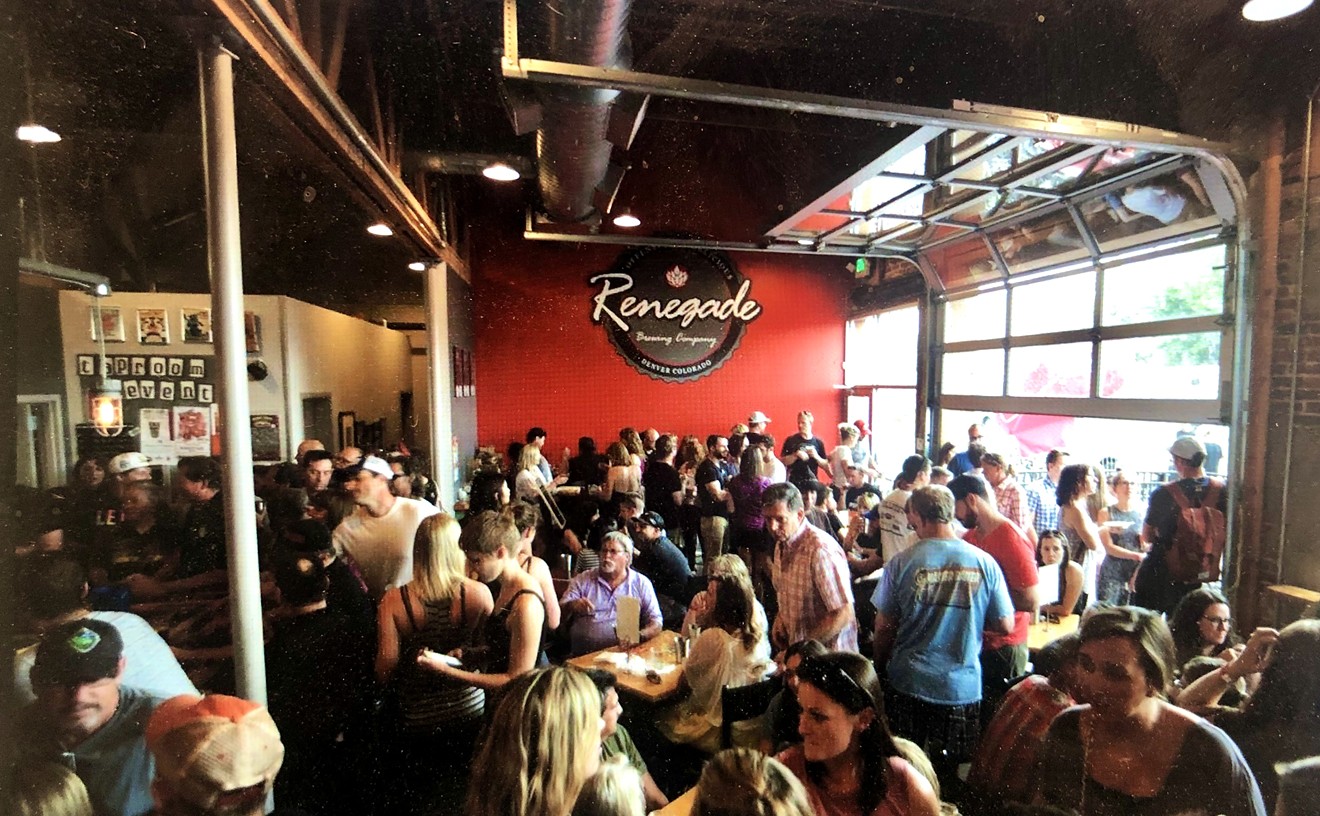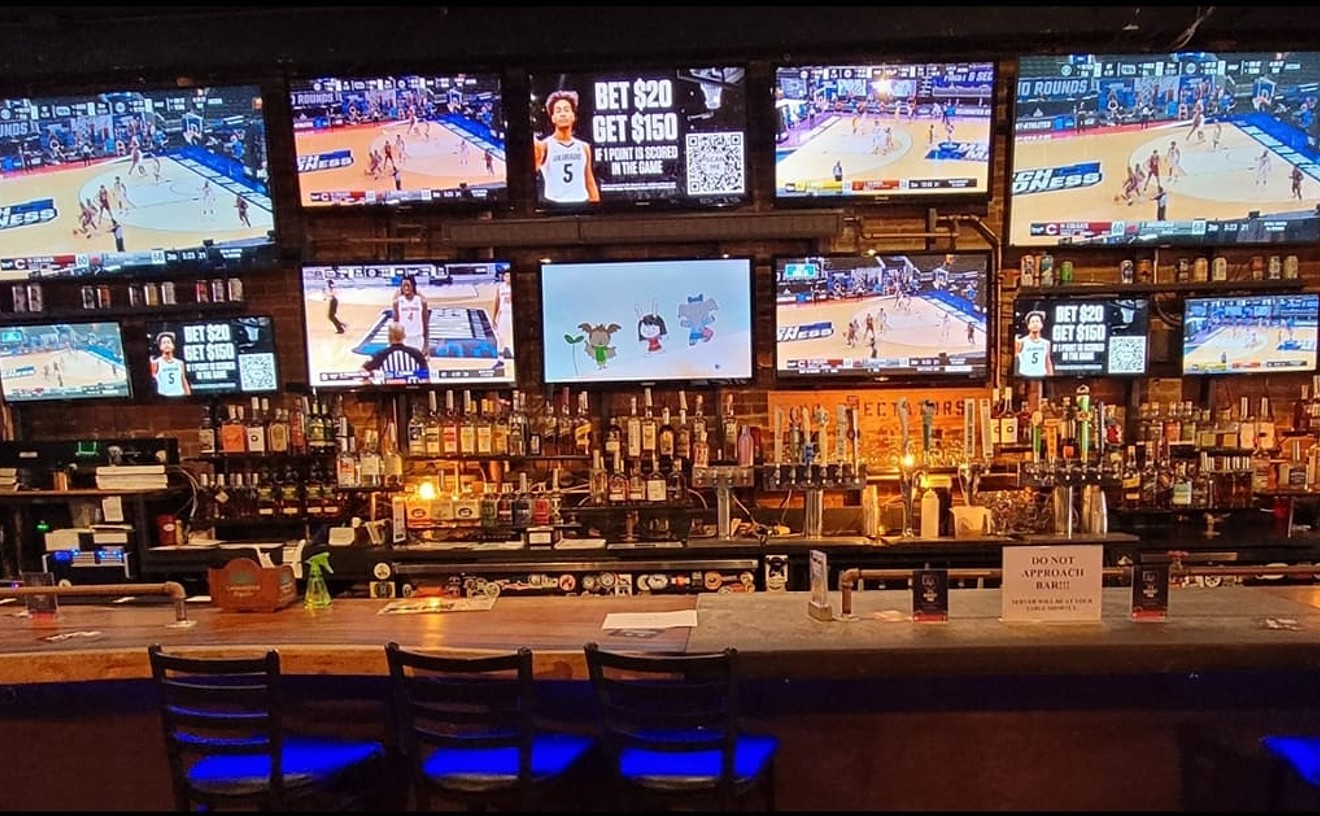To the Hopi, kachinas are spirit-beings associated with rain, corn, animals and other elements critical to life in the desert. Dolls of the same name are crafted for children — not as toys, but as study tools, a three-dimensional catechism for the spirits they represent. Not that you'd grasp this from the splashy Southwestern restaurant of the same name that opened in the Westin Westminster in September. According to the menu, kachinas "represent anything in the natural world or cosmos," including "a location, a quality...or a concept." But the only concept represented at Kachina seems to be a Southwestern cliché straight out of Epcot.
See also: Behind the Scenes at Kachina
Inside the meandering space, twisted trees, apparently shorn of their bark by the elements, are hung with lanterns. Timbers protrude from adobe-like banquettes. A blackened-steel coyote howls in the bar. A partition of pueblo-style niches, open on both sides, divides the dining room from the exhibition kitchen, giving diners (especially in the bar, where stools are tall) a view of the action. The restaurant is lovely but overdone: You half expect the hostess to tell you there's a private kiva for margaritas or a red rock climbing wall for kids.
There isn't. But there is a food cart, a clumsy, gimmicky thing that bumps its way around chairs and shows up soon after you sit down. For months, ears of corn slathered with chipotle butter, cilantro and cheese were on offer; tamales were introduced over the holidays. The idea seems fun in a mood-setting kind of way, until you get the bill and realize, as did a father sitting at a table near me one night, that those amuse-bouches just cost your family $30. With all the attention put into the space, that not-so-minor detail was somehow overlooked in both print and speech.
The menu — with more fonts, colors and cartoons than a kid's activity sheet — only adds to the Epcot vibe, listing a selection of Native American, cowboy and haute Southwestern dishes as expansive as the Western sky. Perhaps executive chef Patrick Hartnett felt compelled to compress so many states, cultures and cuisines into one restaurant to meet the menu's stated goal: "a magical trip through the Southwest."
Whether or not you want to make the journey depends on what you order. House-fried blue-corn tortilla chips arrive doused in salt, making it hard to enjoy the tasty trio of regular, corn and spicy chipotle guacamole. Cold carrots, cauliflower and pickles that come with one special are soaked in so much lime and tequila, servers should card upon delivery. Tamales combine mushrooms and the corn fungus known as huitlacoche in loose, wet masa; drizzled with blue cheese, the flavors seem oddly disjointed, more French than Southwestern. Sweet-potato gratin, a lasagna of sorts with sweet tubers, green chiles and smoked cheddar, arrives burned. A chicken breast paired with thigh-wrapped chorizo suffers the opposite fate, with too little grill time to crisp the skin. Peel off the flabby covering and much of the spice rub comes off, too, leaving a bland piece of bird suitable for picky children. The plate comes with smoked-tomato polenta that might be good if it weren't pressed into such wet, dense triangles.
A dish named Three Sisters — for the corn, squash and beans that were the staples of ancestral Puebloan cuisine — hits the trifecta of small, expensive and disappointing. Two ravioli, in dough made from pulverized dried corn kernels, are stuffed with mushrooms and huitlacoche and fried to a deep brown, edges pinched and crisp like pie crust. Too bad they're not pie, which is just as good hot as cold, because that's how the ravioli arrived one night, with all the appeal of yesterday's french fries. On the same plate, the ancho relleno, a dried, reconstituted pepper that cradles calabacitas stuffing, almost redeems the trio, but large chunks of squash make for an awkward mouthful.
Other fare promises a better trip. Sliders, a special on the stand-alone "Chef and Butcher" menu featuring grass-fed beef butchered in-house, are well-seasoned, with housemade chile-laden buns to complement the aged, high-quality beef. Navajo tacos, with puffy fry bread substituted for hard corn shells, are delicious. Seven variations are listed on the menu, including the Santa Fe, with house-smoked chicken and charred tomato salsa, and the Pueblo, with shredded pork marinated overnight in achiote paste.
Beef tenderloin rings (filetes a la plancha) get lots of love from a wrapper of crisp speck. Green-chile corn chowder, thick with kernels, pairs the earthiness of corn with hearty chicken and potatoes. Two small loaves of bison meatloaf are tender and slightly smoky, and the flavors blend harmoniously with a side of quinoa corn pudding. Quail, one of ten offerings from the grill, hints at mesquite and spices rubbed on the tiny birds. Pork posole rojo, in a rich stock flavored with hog's head and three kinds of chiles, tempts with morsels of browned pork and heirloom hominy that splays out like a flower. And for a satisfying final destination, brake for chocolate-and-chile-filled beignets, dusted in cinnamon and sugar and dipped in goat's-milk caramel.
As executive chef at more than a dozen restaurants during his thirty-two years in the business, Hartnett has not just experience, but lofty intentions, which is why beef is butchered on site, buns and pastas are scratch-made, and local ranchers and farmers get favored status. He also has a real Southwest pedigree, including a decade in Taos and Santa Fe, where he worked with Mark Miller, founder of the famed Coyote Cafe. So I don't doubt him when he says that at Kachina, he's trying to "bring Southwestern cuisine back into vogue."
To do that, though, he should ditch the bus tour and edit the menu into a selection of dishes that can be executed day in and day out. Plating deserves more attention, too, and staff requires more training. (One night, a server responded to questions about dessert by taking the menu from my hands and reading verbatim.) Is Hartnett's goal far away? Currently, yes. But a journey of a thousand miles begins with a single step.










